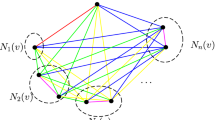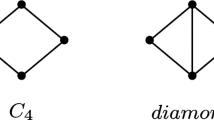Abstract
The first-fit coloring is a heuristic that assigns to each vertex, arriving in a specified order \(\sigma \), the smallest available color. The problem Grundy Coloring asks how many colors are needed for the most adversarial vertex ordering \(\sigma \), i.e., the maximum number of colors that the first-fit coloring requires over all possible vertex orderings. Since its inception by Grundy in 1939, Grundy Coloring has been examined for its structural and algorithmic aspects. A brute-force \(f(k)n^{2^{k-1}}\)-time algorithm for Grundy Coloring on general graphs is not difficult to obtain, where k is the number of colors required by the most adversarial vertex ordering. It was asked several times whether the dependency on k in the exponent of n can be avoided or reduced, and its answer seemed elusive until now. We prove that Grundy Coloring is W[1]-hard and the brute-force algorithm is essentially optimal under the Exponential Time Hypothesis, thus settling this question by the negative. The key ingredient in our W[1]-hardness proof is to use so-called half-graphs as a building block to transmit a color from one vertex to another. Leveraging the half-graphs, we also prove that \(b\)-Chromatic Core is W[1]-hard, whose parameterized complexity was posed as an open question by Panolan et al. [JCSS ’17]. A natural follow-up question is, how the parameterized complexity changes in the absence of (large) half-graphs. We establish fixed-parameter tractability on \(K_{t,t}\)-free graphs for \(b\)-Chromatic Core and Partial Grundy Coloring, making a step toward answering this question. The key combinatorial lemma underlying the tractability result might be of independent interest.





Similar content being viewed by others
Notes
It is not difficult to see that there is a \(\chi (G)\)-coloring of G which is a b-coloring as well, where \(\chi (G)\) is the chromatic number of G.
References
Aboulker, P., Bang-Jensen, J., Bousquet, N., Charbit, P., Havet, F., Maffray, F., Zamora, J.: \(\chi \)-bounded families of oriented graphs. J. Graph Theory 89(3), 304–326 (2018). https://doi.org/10.1002/jgt.22252
Alon, N., Yuster, R., Zwick, U.: Color-coding. J. ACM 42(4), 844–856 (1995)
Bonnet, É., Bousquet, N., Charbit, P., Thomassé, S., Watrigant, R.: Parameterized complexity of independent set in h-free graphs. In: 13th International Symposium on Parameterized and Exact Computation, IPEC 2018, August 20–24, 2018, Helsinki, Finland, pp. 17:1–17:13 (2018). https://doi.org/10.4230/LIPIcs.IPEC.2018.17
Bonnet, É., Foucaud, F., Kim, E.J., Sikora, F.: Complexity of Gundy coloring and its variants. Discrete Appl. Math. 243, 99–114 (2018). https://doi.org/10.1016/j.dam.2017.12.022
Cai, L.: Parameterized complexity of cardinality constrained optimization problems. Comput. J. 51(1), 102–121 (2008). https://doi.org/10.1093/comjnl/bxm086
Cai, L., Chan, S.M., Chan, S.O.: Random separation: a new method for solving fixed-cardinality optimization problems. In: Parameterized and Exact Computation, Second International workshop, IWPEC 2006, Zürich, Switzerland, September 13–15, 2006, Proceedings, pp. 239–250 (2006). https://doi.org/10.1007/11847250_22
Cesati, M.: The Turing way to parameterized complexity. J. Comput. Syst. Sci. 67(4), 654–685 (2003). https://doi.org/10.1016/S0022-0000(03)00073-4
Chen, J., Huang, X., Kanj, I.A., Xia, G.: Strong computational lower bounds via parameterized complexity. J. Comput. Syst. Sci. 72(8), 1346–1367 (2006). https://doi.org/10.1016/j.jcss.2006.04.007
Chitnis, R., Cygan, M., Hajiaghayi, M.T., Pilipczuk, M., Pilipczuk, M.: Designing FPT algorithms for cut problems using randomized contractions. SIAM J. Comput. 45(4), 1171–1229 (2016). https://doi.org/10.1137/15M1032077
Christen, C.A., Selkow, S.M.: Some perfect coloring properties of graphs. J. Comb. Theory Ser. B 27(1), 49–59 (1979)
Cygan, M., Fomin, F.V., Kowalik, L., Lokshtanov, D., Marx, D., Pilipczuk, M., Pilipczuk, M., Saurabh, S.: Parameterized Algorithms. Springer, Berlin (2015). https://doi.org/10.1007/978-3-319-21275-3
Diestel, R.: Graph Theory, Volume 173 of Graduate Texts in Mathematics, 4th edn. Springer, Berlin (2012)
Downey, R.G., Fellows, M.R.: Fundamentals of Parameterized Complexity. Springer, Berlin (2013)
Effantin, B., Gastineau, N., Togni, O.: A characterization of b-chromatic and partial Grundy numbers by induced subgraphs. Discrete Math. 339(8), 2157–2167 (2016). https://doi.org/10.1016/j.disc.2016.03.011
Erdős, P., Hare, W.R., Hedetniemi, S.T., Laskar, R.: On the equality of the Grundy and ochromatic numbers of a graph. J. Graph Theory 11(2), 157–159 (1987)
Erdős, P., Hedetniemi, S.T., Laskar, R.C., Prins, G.C.E.: On the equality of the partial Grundy and upper ochromatic numbers of graphs. Discrete Math. 272(1), 53–64 (2003). (In Honor of Frank Harary)
Erdös, P.: Some combinatorial, geometric and set theoretic problems in measure theory. In: Measure Theory Oberwolfach 1983, pp. 321–327. Springer (1984)
Feldmann, A.E., Marx, D.: The parameterized hardness of the k-center problem in transportation networks. In: 16th Scandinavian Symposium and Workshops on Algorithm Theory, SWAT 2018, June 18–20, 2018, Malmö, Sweden, pp. 19:1–19:13 (2018). https://doi.org/10.4230/LIPIcs.SWAT.2018.19
Garey, M.R., Johnson, D.S.: Computers and Intractability: A Guide to the Theory of NP-Completeness. W. H. Freeman, New York (1979)
Gastineau, N.: Partitionnement, recouvrement et colorabilité dans les graphes. (Partitionability, coverability and colorability in graphs). PhD thesis, University of Burgundy, Dijon, France (2014). https://tel.archives-ouvertes.fr/tel-01136691
Grohe, M., Kreutzer, S., Siebertz, S.: Deciding first-order properties of nowhere dense graphs. J. ACM 64(3), 17:1-17:32 (2017). https://doi.org/10.1145/3051095
Grundy, P.M.: Mathematics and games. Eureka 2, 6–8 (1939)
Gyárfás, A., Király, Z., Lehel, J.: On-line 3-chromatic graphs-II critical graphs. Discrete Math. 177(1–3), 99–122 (1997)
Havet, F., Maia, A.K., Min-Li, Yu.: Complexity of greedy edge-colouring. J. Braz. Comput. Soc. 21(1), 18:1-18:7 (2015). https://doi.org/10.1186/s13173-015-0036-x
Havet, F., Sampaio, L.: On the Grundy and b-chromatic numbers of a graph. Algorithmica 65(4), 885–899 (2013)
Hedetniemi, S.M., Hedetniemi, S.T., Beyer, T.: A linear algorithm for the Grundy (coloring) number of a tree. Congr. Numer. 36, 351–363 (1982)
Impagliazzo, R., Paturi, R., Zane, F.: Which problems have strongly exponential complexity? J. Comput. Syst. Sci. 63(4), 512–530 (2001)
Lokshtanov, D., Marx, D., Saurabh, S.: Lower bounds based on the exponential time hypothesis. Bull. EATCS 105, 41–72 (2011)
Marx, D.: Parameterized complexity of independence and domination on geometric graphs. In: Parameterized and Exact Computation, Second International Workshop, IWPEC 2006, Zürich, Switzerland, September 13–15, 2006, Proceedings, pp. 154–165 (2006). https://doi.org/10.1007/11847250_14
Marx, Dániel: On the optimality of planar and geometric approximation schemes. In: 48th Annual IEEE Symposium on Foundations of Computer Science (FOCS 2007), October 20–23, 2007, Providence, RI, USA, Proceedings, pp. 338–348 (2007). https://doi.org/10.1109/FOCS.2007.50
Marx, D.: Can you beat treewidth? Theory Comput. 6(1), 85–112 (2010). https://doi.org/10.4086/toc.2010.v006a005
Marx, D., Pilipczuk, M.: Optimal parameterized algorithms for planar facility location problems using voronoi diagrams. CoRR (2015). arXiv:1504.05476
Marx, D., Pilipczuk, M.: Optimal parameterized algorithms for planar facility location problems using voronoi diagrams. In: Algorithms-ESA 2015-23rd Annual European Symposium, Patras, Greece, September 14–16, 2015, Proceedings, pp. 865–877 (2015). https://doi.org/10.1007/978-3-662-48350-3_72
Naor, M., Schulman, L.J., Srinivasan, A.: Splitters and near-optimal derandomization. In: 36th Annual Symposium on Foundations of Computer Science, Milwaukee, Wisconsin, USA, 23–25 October 1995, pp. 182–191. IEEE Computer Society (1995). https://doi.org/10.1109/SFCS.1995.492475
Panolan, F., Philip, G., Saurabh, S.: On the parameterized complexity of b-chromatic number. J. Comput. Syst. Sci. 84, 120–131 (2017). https://doi.org/10.1016/j.jcss.2016.09.012
Sampaio, L.: Algorithmic Aspects of Graph Colouring Heuristics. PhD thesis, University of Nice-Sophia Antipolis, November (2012)
Simmons, G.J.: The ochromatic number of graphs. Graph Theory Newsl. 11(6), 2–3 (1982)
Telle, J.A., Proskurowski, A.: Algorithms for vertex partitioning problems on partial k-trees. SIAM J. Discrete Math. 10(4), 529–550 (1997)
Telle, J.A., Villanger, Y.: FPT algorithms for domination in biclique-free graphs. In: Epstein, L., Ferragina, P. (eds.) Algorithms-ESA 2012-20th Annual European Symposium, Ljubljana, Slovenia, September 10–12, 2012. Proceedings, Volume 7501 of Lecture Notes in Computer Science, pp. 802–812. Springer (2012). https://doi.org/10.1007/978-3-642-33090-2_69
Zaker, M.: The Grundy chromatic number of the complement of bipartite graphs. Australas. J. Comb. 31, 325–329 (2005)
Zaker, M.: Results on the Grundy chromatic number of graphs. Discrete Math. 306(23), 3166–3173 (2006)
Acknowledgements
A part of this work was done while the authors attended the “2019 IBS Summer research program on Algorithms and Complexity in Discrete Structures”, hosted by the IBS discrete mathematics group. The third and the fourth authors were partially supported by the ANR project “ESIGMA” (ANR-17-CE23-0010)
Author information
Authors and Affiliations
Corresponding author
Additional information
Publisher's Note
Springer Nature remains neutral with regard to jurisdictional claims in published maps and institutional affiliations.
Rights and permissions
About this article
Cite this article
Aboulker, P., Bonnet, É., Kim, E.J. et al. Grundy Coloring and Friends, Half-Graphs, Bicliques. Algorithmica 85, 1–28 (2023). https://doi.org/10.1007/s00453-022-01001-2
Received:
Accepted:
Published:
Issue Date:
DOI: https://doi.org/10.1007/s00453-022-01001-2
Keywords
- Grundy coloring
- Parameterized complexity
- ETH lower bounds
- \(K_{t</Keyword> <Keyword>t}\)-free graphs
- Half-graphs




